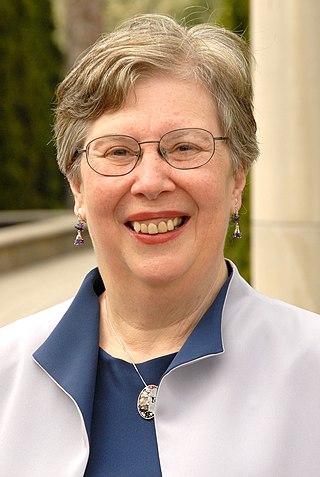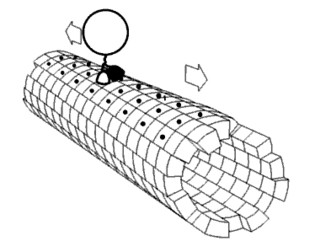Related Research Articles

Potassium channels are the most widely distributed type of ion channel found in virtually all organisms. They form potassium-selective pores that span cell membranes. Potassium channels are found in most cell types and control a wide variety of cell functions.

Eva Nogales is a Spanish-American biophysicist at the Lawrence Berkeley National Laboratory and a professor at the University of California, Berkeley, where she served as head of the Division of Biochemistry, Biophysics and Structural Biology of the Department of Molecular and Cell Biology (2015–2020). She is a Howard Hughes Medical Institute investigator.

Molecular biophysics is a rapidly evolving interdisciplinary area of research that combines concepts in physics, chemistry, engineering, mathematics and biology. It seeks to understand biomolecular systems and explain biological function in terms of molecular structure, structural organization, and dynamic behaviour at various levels of complexity. This discipline covers topics such as the measurement of molecular forces, molecular associations, allosteric interactions, Brownian motion, and cable theory. Additional areas of study can be found on Outline of Biophysics. The discipline has required development of specialized equipment and procedures capable of imaging and manipulating minute living structures, as well as novel experimental approaches.
Axel T. Brunger is a German American biophysicist. He is Professor of Molecular and Cellular Physiology at Stanford University, and a Howard Hughes Medical Institute Investigator. He served as the Chair of the Department of Molecular and Cellular Physiology (2013–2017).

Helen Miriam Berman is a Board of Governors Professor of Chemistry and Chemical Biology at Rutgers University and a former director of the RCSB Protein Data Bank. A structural biologist, her work includes structural analysis of protein-nucleic acid complexes, and the role of water in molecular interactions. She is also the founder and director of the Nucleic Acid Database, and led the Protein Structure Initiative Structural Genomics Knowledgebase.

Two pore segment channel 1 (TPC1) is a human protein encoded by the TPCN1 gene. The protein encoded by this gene is an ion channel. In contrast to other calcium and sodium channels which have four homologous domains, each containing six transmembrane segments, TPCN1 only contains two domains.
Ignacio "Nacho" Tinoco Jr. was a Professor of Chemistry at the University of California, Berkeley from 1956 to 2016.

A Per-Arnt-Sim (PAS) domain is a protein domain found in all kingdoms of life. Generally, the PAS domain acts as a molecular sensor, whereby small molecules and other proteins associate via binding of the PAS domain. Due to this sensing capability, the PAS domain has been shown as the key structural motif involved in protein-protein interactions of the circadian clock, and it is also a common motif found in signaling proteins, where it functions as a signaling sensor.

In molecular biology, proteins are generally thought to adopt unique structures determined by their amino acid sequences. However, proteins are not strictly static objects, but rather populate ensembles of conformations. Transitions between these states occur on a variety of length scales and time scales , and have been linked to functionally relevant phenomena such as allosteric signaling and enzyme catalysis.

Mamannamana Vijayan was an Indian structural biologist.

Thomas Felix Rosenbaum is an American condensed matter physicist, professor of physics, and the current president of the California Institute of Technology (Caltech). Previously, Rosenbaum served as a faculty member and Provost of the University of Chicago. He has also served as the vice president for research at Argonne National Laboratory.

Stephen C. Harrison is professor of biological chemistry and molecular pharmacology, professor of pediatrics, and director of the Center for Molecular and Cellular Dynamics of Harvard Medical School, head of the Laboratory of Molecular Medicine at Boston Children's Hospital, and investigator of the Howard Hughes Medical Institute.
Klaus Schulten was a German-American computational biophysicist and the Swanlund Professor of Physics at the University of Illinois at Urbana-Champaign. Schulten used supercomputing techniques to apply theoretical physics to the fields of biomedicine and bioengineering and dynamically model living systems. His mathematical, theoretical, and technological innovations led to key discoveries about the motion of biological cells, sensory processes in vision, animal navigation, light energy harvesting in photosynthesis, and learning in neural networks.
Kanakaraj Sekar is an Indian bioinformatician and a professor at the Department of Computational and Data Sciences of the Indian Institute of Science (IISc). Known for his studies in the field of bioinformatics, Sekar heads the Laboratory for Structural Biology and Bio-computing at IISc. The Department of Biotechnology of the Government of India awarded him the National Bioscience Award for Career Development, one of the highest Indian science awards, for his contributions to biosciences in 2004.
In molecular biology, the PYP domain is a p-coumaric acid-binding protein domain. They are present in various proteins in bacteria.

Serial femtosecond crystallography (SFX) is a form of X-ray crystallography developed for use at X-ray free-electron lasers (XFELs). Single pulses at free-electron lasers are bright enough to generate resolvable Bragg diffraction from sub-micron crystals. However, these pulses also destroy the crystals, meaning that a full data set involves collecting diffraction from many crystals. This method of data collection is referred to as serial, referencing a row of crystals streaming across the X-ray beam, one at a time.
Ka Yee Christina Lee is Hong Kong-born American chemist. She is Executive Vice President for Strategic Initiatives and the David Lee Shillinglaw Distinguished Service Professor in the Department of Chemistry at the University of Chicago. She works on membrane biophysics, including protein–lipid interactions, Alzheimer's disease and respiratory distress syndrome. She is a Fellow of the American Institute for Medical and Biological Engineering and American Physical Society.
Marta Cecilia del Carmen Bunster Balocchi is a Chilean scientist, most noted for her work in the fields of biochemistry, biophysics and crystallography. She is also known as one of the main promoters of bioinformatics in her country.

Janos Hajdu is a Swedish/Hungarian scientist, who has made contributions to biochemistry, biophysics, and the science of X-ray free-electron lasers. He is a professor of molecular biophysics at Uppsala University and a leading scientist at the European Extreme Light Infrastructure ERIC in Prague.

Jürgen Engel is a German-born Swiss chemist and biophysicist.
References
- ↑ "Keith Moffat's Profile on Academic Tree".
- ↑ Krebs, Werner G. (1996). Kinetic Analysis and Intermediate Structure Determination from High-Speed Time-Resolved Crystallography (MS thesis). University of Chicago. OCLC 923013077.
- 1 2 3 "John Moffat | The University of Edinburgh". www.ed.ac.uk. Retrieved 2015-11-20.
- 1 2 "University of Chicago names Deputy Provost for Research". www-news.uchicago.edu. Retrieved 2015-11-20.
- ↑ "Moffat Appointed Senior Advisor for Life Sciences at the APS". www.aps.anl.gov. Archived from the original on 2016-03-16. Retrieved 2015-11-20.
- ↑ "The Faculty | Chicago Biophysics | University of Chicago". biophysics.uchicago.edu. Retrieved 2015-11-20.
- ↑ "Distinguished faculty receive endowed chairs". chronicle.uchicago.edu. Retrieved 2015-11-20.
- ↑ "Keith Moffat on LinkedIn".
- ↑ "Bright Ideas | The Scientist Magazine®". The Scientist. Retrieved 2015-11-20.